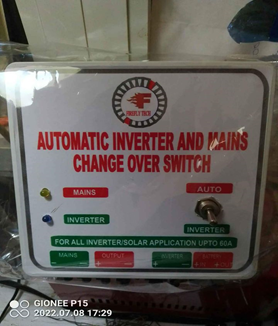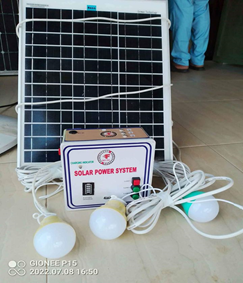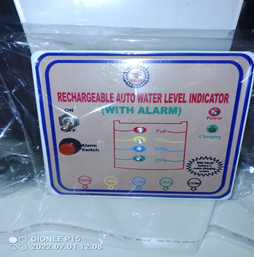A COMPREHENSIVE LITERATURE REVIEW OF 55YEARS OF FUZZY SET THEORY
USER'S INSTRUCTIONS: The project work you are about to view is on "a comprehensive literature review of 55years of fuzzy set theory". Please, sit back and study the below research material carefully. This project topic (a comprehensive literature review of 55years of fuzzy set theory) have complete 5(five) Chapters. The complete Project Material/writeup include: Abstract + Introduction + etc + Literature Review + methodology + etc + Conclusion + Recommendation + References/Bibliography.Our aim of providing this "a comprehensive literature review of 55years of fuzzy set theory" project research material is to reduce the stress of moving from one school library to another all in the name of searching for "a comprehensive literature review of 55years of fuzzy set theory" research materials. We are not encouraging any form of plagiarism. This service is legal because, all institutions permit their students to read previous projects, books, articles or papers while developing their own works.
TITLE PAGE
BY
---
--/H2013/01430
DEPARTMENT OF ----
SCHOOL OF ---
INSTITUTE OF ---
DECEMBER,2018
APPROVAL PAGE
This is to certify that the research work, "a comprehensive literature review of 55years of fuzzy set theory" by ---, Reg. No. --/H2007/01430 submitted in partial fulfillment of the requirement award of a Higher National Diploma on --- has been approved.
By
--- . ---
Supervisor Head of Department.
Signature………………. Signature……………….
……………………………….
---
External Invigilator
DEDICATION
This project is dedicated to Almighty God for his protection, kindness, strength over my life throughout the period and also to my --- for his financial support and moral care towards me.Also to my mentor --- for her academic advice she often gives to me. May Almighty God shield them from the peril of this world and bless their entire endeavour Amen.
ACKNOWLEDGEMENT
The successful completion of this project work could not have been a reality without the encouragement of my --- and other people. My immensely appreciation goes to my humble and able supervisor mr. --- for his kindness in supervising this project.
My warmest gratitude goes to my parents for their moral, spiritual and financial support throughout my study in this institution.
My appreciation goes to some of my lecturers among whom are Mr. ---, and Dr. ---. I also recognize the support of some of the staff of --- among whom are: The General Manager, Deputy General manager, the internal Auditor Mr. --- and the ---. Finally, my appreciation goes to my elder sister ---, my lovely friends mercy ---, ---, --- and many others who were quite helpful.
PROJECT DESCRIPTION: This work "a comprehensive literature review of 55years of fuzzy set theory" research material is a complete and well researched project material strictly for academic purposes, which has been approved by different Lecturers from different higher institutions. We made Preliminary pages, Abstract and Chapter one of "a comprehensive literature review of 55years of fuzzy set theory" visible for everyone, then the complete material on "a comprehensive literature review of 55years of fuzzy set theory" is to be ordered for. Happy viewing!!!
This work is on a “comprehensive literature review of 55years of fuzzy set theory”. Fuzzy sets have a great progress in every scientific research area. It found many application areas in both theoretical and practical studies from engineering area to arts and humanities, from computer science to health sciences, from life sciences to physical sciences and also in business, administration and accounting. In this work, a comprehensive literature review on the fuzzy set theory is realized. In the recent years, ordinary fuzzy sets have been extended to new types and these extensions have been used in many areas such as energy, medicine, material, economics and pharmacology sciences. This literature review also analyzes the chronological development of these extensions.
TABLE OF CONTENTS
Cover page
Title page
Approval page
Dedication
Acknowledgement
Abstract
CHAPTER ONE
1.0 Introduction
1.1 background of the study
- statement of problem
- aim and objective of the project
- definition of terms
CHAPTER TWO
2.0 LITERATURE REVIEW
- Overview of fuzzy sets
- Fuzzy Set Theory and Fuzzy Logic
- review of previous studies (from 1965-2020)
CHAPTER THREE
3.1 Material Used
3.2 Fuzzy Set Theory with Graphical Illustrations
3.3 Subject Areas of Fuzzy Publications
CHAPTER FOUR
4.0 Result and discussion
CHAPTER FIVE
- Conclusion
- Recommendation
- References
CHAPTER ONE
INTRODUCTION
-
Background of Study
According to Zadeh (1965), a fuzzy set is a class of objects whose memberships are not precisely defined. Fuzzy sets provide a better representation of reality than the classical mathematical binary representation. The membership in fuzzy sets is gradual,that makes the theory invaluable to represent the limited level of precision in mental representations (Dubois, 2000).
Most of our traditional tools for formal modeling, reasoning, and computing are crisp, deterministic, and precise in character. Crisp means dichotomous, that is, yes-or-no type rather than more-or-less type. In traditional dual logic, for instance, a statement can be true or false—and nothing in between. In set theory, an element can either belong to a set or not; in optimization a solution can be feasible or not. Precision assumes that the parameters of a model represent exactly the real system that has been modeled. This, generally, also implies that the model is unequivocal, that is, that it contains no ambiguities. Certainty eventually indicates that we assume the structures and parameters of the model to be definitely known and that there are no doubts about their values or their occurrence. Unluckily these assumptions and beliefs are not justified if it is important, that the model describes well reality (which is neither crisp nor certain). In addition, the complete description of a real system would often require far more detailed data than a human being could ever recognize simultaneously, process, and understand. This situation has already been recognized by thinkers in the past. In 1923, the philosopher B. Russell referred to the first point when he wrote: ‘All traditional logic habitually assumes that precise symbols are being employed. It is, therefore, not applicable to this terrestrial life but only to an imagined celestial existence’ according to Russell (1923). L. Zadeh referred to the second point, when he wrote: ‘As the complexity of a system increases, our ability to make precise and yet significant statements about its behavior diminishes until a threshold is reached beyond which precision and significance (or relevance) become almost mutually exclusive characteristics’ (Zadeh, 1973). For a long time, probability theory and statistics have been the predominant theories and tools to model uncertainties of reality (Zadeh, 2005). They are based—as all formal theories—on certain axiomatic assumptions, which are hardly ever tested, when these theories are applied to reality. In the meantime more than 20 other ‘uncertainty theories’ have been developed, which partly contradict each other and partly complement each other. Fuzzy set theory—formally speaking—is one of these theories, which was initially intended to be an extension of dual logic and/or classical set theory.
Lotfi Asker Zadeh been the founder of the fuzzy set theory published his first paper on his new theory in 1965. Between 1965 and 1975, Zadeh broadened the foundation of the fuzzy set theory by establishing fuzzy similarity relations, linguistic hedges, and fuzzy decision-making. In 1970s, some research groups in Japan started to study the fuzzy set theory. In 1970, Mamdani developed the first fuzzy logic controller. In 1977, some industrial applications of fuzzy logic began in Japan and Europe. The success of fuzzy logic was observed in Japan at the beginning of 1980s and this led to a revival in fuzzy logic in the US at the end of 1980s.
Along with the emergence of the fuzzy set theory, many objections to the theory have appeared (2008). Those brilliant scientists could not accept Zadeh’s way of handling the uncertainty. They so much exaggerated in decrying it that the logic of the theory was defined as “Fuzzy logic is the cocaine of science." However, the fuzzy logic proved its power through the real technology applications.
One of the well-known applications of fuzzy logic is that of the Sendai Subway system that went into operation in 1988 in Sendai, Japan. For the control of lines, a fuzzy controller was used to run the train all day long. Through the fuzzy controller, the line became one of the smoothest running subway systems in the world. The commercial appliances such as heating ventilation and air conditioning (HVAC) systems have used fuzzy logic thermostats to control the heating and cooling thus saved energy by making the system more efficient and keeping the temperature more steady than a traditional thermostat. Fuzzy logic control systems have also been used to control the speed of cars based on the obstacle sensed. The system is composed of a sensor in the front panel to sense the presence of obstacles. Fuzzy logic based Programmable Logic Controllers (PLCs) have been developed by companies like Moeller, one of the longest-established and most respected names in the electrical sector. Fuzzy logic has also been used in 3D animation systems for generating crowds as it was used extensively in the making of the Lord of the Rings.
This work presents an extended comprehensive literature review for the fuzzy set theory. It aims at exhibiting the expansion areas of the fuzzy set theory in its 55th year.
- 2 Statement of the Problem
Fuzzy set theory has been used extensively in fields of complexity, cognitive sciences, and artificial intelligence, especially in numerous fields such as expert systems, knowledge discovery, information system, inductive reasoning, intelligent systems, data mining, pattern recognition, decision-making, and machine learning. Rough sets models, which have been recently proposed, are developed applying the different fuzzy generalizations. Currently, there is not a systematic literature review and classification of these new generalizations about set models for a long time, all the reviewed works have been limited on the one done from 1965 to 2015. Therefore, in this work review study was made to provide an extension of a comprehensive systematic review of methodologies and applications of recent generalisations discussed in the area of fuzzy set theory from 1965 to 2020.
- 3 Aim and Objectives
The purpose of this study is to provide an in-depth presentation of the extension and contributions of fuzzy set theory in more field of life. The objectives of this study are:
- To study the various applications of fuzzy set theory
- To exhibit the expansion areas of the fuzzy set theory in its 55th year (that is, from 1965-2020) and presents the results of literature review with graphical illustrations and a classification with respect to the extensions of fuzzy sets.
- To study different publications on fuzzy set theory
- 4 Definition of terms
Terms that are frequently used in this work are defined as below:
Fuzzification: Fuzzification is the process of assigning the numerical input of a system to fuzzy sets with some degree of membership.
Fuzzy logic is a form of many-valued logic in which the truth value of variables may be any real number between 0 and 1.
Set theory: branch of mathematics which deals with the formal properties of sets as units (without regard to the nature of their individual constituents) and the expression of other branches of mathematics in terms of sets.
CHAPTER TWO: The chapter one of this work has been displayed above. The complete chapter two of "a comprehensive literature review of 55years of fuzzy set theory" is also available. Order full work to download. Chapter two of "a comprehensive literature review of 55years of fuzzy set theory" consists of the literature review. In this chapter all the related works on "a comprehensive literature review of 55years of fuzzy set theory" were reviewed.
CHAPTER THREE: The complete chapter three of "a comprehensive literature review of 55years of fuzzy set theory" is available. Order full work to download. Chapter three of "a comprehensive literature review of 55years of fuzzy set theory" consists of the methodology. In this chapter all the method used in carrying out this work was discussed.
CHAPTER FOUR: The complete chapter four of "a comprehensive literature review of 55years of fuzzy set theory" is available. Order full work to download. Chapter four of "a comprehensive literature review of 55years of fuzzy set theory" consists of all the test conducted during the work and the result gotten after the whole work
CHAPTER FIVE: The complete chapter five of design and construction of a "XX" is available. Order full work to download. Chapter five of "a comprehensive literature review of 55years of fuzzy set theory" consist of conclusion, recommendation and references.
To "DOWNLOAD" the complete material on this particular topic above click "HERE"
Do you want our Bank Accounts? please click HERE
To view other related topics click HERE
To "SUMMIT" new topic(s), develop a new topic OR you did not see your topic on our site but want to confirm the availiability of your topic click HERE
Do you want us to research your new topic? if yes, click "HERE"
Do you have any question concerning our post/services? click HERE for answers to your questions
For more information contact us through any of the following means:
Mobile No ![]() :+2348146561114 or +2347015391124 [Mr. Innocent]
:+2348146561114 or +2347015391124 [Mr. Innocent]
Email address ![]() :engr4project@gmail.com
:engr4project@gmail.com
COUNTRIES THAT FOUND OUR SERVICES USEFUL
Australia, Botswana, Canada, Europe, Ghana, Ireland, India, Kenya, Liberia, Malaysia, Namibia, New Zealand, Nigeria, Pakistan, Philippines, Singapore, Sierra Leone, South Africa, Uganda, United States, United Kindom, Zambia, Zimbabwe, etc
Support: +234 8146561114 or +2347015391124
Watsapp No :+2348146561114
:+2348146561114
Email Address  :engr4project@gmail.com
:engr4project@gmail.com
FOLLOW / VISIT US VIA:













